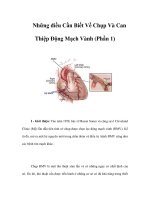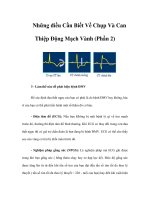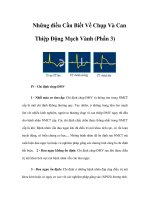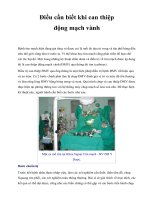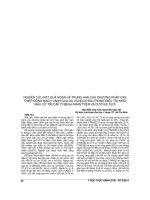Tiêu chuẩn mới và triển vọng can thiệp động mạch vành cấp trong tương lai
Bạn đang xem bản rút gọn của tài liệu. Xem và tải ngay bản đầy đủ của tài liệu tại đây (2.75 MB, 37 trang )
Future Directions in
Treatment of STEMI
Vietnam Heart Association Meeting
Danang October 12, 2014
Thach Nguyen MD FACC FSCAI
Director of Cardiology
St Mary Medical Center, Hobart IN
1. P2Y12 inhibitor for CAD
• Jernberg T, Payne CD, Winters KJ, Darstein C,
Brandt JT, Jakubowski JA, Naganuma H,
Siegbahn A, Wallentin L. Prasugrel achieves
greater inhibition of platelet aggregation and a
lower rate of non-responders compared with
clopidogrel in aspirin-treated patients with stable
coronary artery disease. Eur Heart J
2006;27:1166–1173.
• Gurbel PA, Bliden KP, Butler K, Tantry US, Gesheff
T,Wei C, Teng R, Antonino MJ, Patil SB, Karunakaran
A, Kereiakes DJ, Parris C, Purdy D, Wilson V, Ledley
GS, Storey RF. Randomized double-blind assessment of
the ONSET and OFFSET of the antiplatelet effects of
ticagrelor versus clopidogrel in patients with stable
coronary artery disease: theONSET/OFFSET study.
Circulation 2009;120:2577–2585
• Substudy of 7544 STEMI patients with planned
PCI from the PLATO Trial
• Ticagrelor was superior to clopidogrel
–
–
Primary endpoint (composite of MI, stroke, CV death)
Secondary endpoints (MI alone, total mortality, stent
thrombosis)
• Major bleeding not increased
• Circulation. 2010;122:2131-2141
Pre-hospital ticagrelor ?
• ATLANTIC trial (N Engl J Med 2014;371:101627) 1862 STEMI patients with ambulance vs cath
lab ticagrelor
• Ambulance group treated 31 minutes earlier
• No difference in pre-PCI coronary reperfusion (by
ECG or TIMI flow)
• Stent thrombosis reduced
• No increased risk of bleeding
ACC/AHA 2013 STEMI Guidelines
CLASS I
ESC 2012 STEMI Guidelines
2. Anticoagulant for PCI
Guidelines regarding bivalirudin
for primary PCI
Source
2012 ESC
(Eur Heart J
2012;33,2569-2619)
2013 ACC/AHA
(JACC 2013;61,e78-140)
2013 ACC/AHA
(JACC 2013;61,e78-140)
Recommendation
Class
Level
Bivalirudin (with use of GP2b/3a blocker restricted to
bailout) is recommended over unfractionated heparin
and a GP 2b/3a blocker.
I
B
I
B
IIa
B
Bivalirudin, with or without prior treatment with
unfractionated heparin, for patients with STEMI
undergoing primary PCI
In patients with STEMI undergoing PCI who are at
high risk of bleeding it is reasonable to use bivalirudin
monotherapy in preference to UFH and a GP 2b/3a
HEAT PPCI
Heparin vs Bivalirudin in Primary
PCI
• Single center randomized controlled trial
(Liverpool, UK)
• Feb 2012 – Nov 2013
• STEMI patients
–
–
–
Heparin 70 U/kg
Bivalirudin 0.75 mg/kg bolus, 1.75 mg/kg/hr
infusion
Selective (bailout) abciximab
• Primary outcome at 28 days
HEAT PPCI
Procedural characteristics
• Radial access 80%
• P2Y12
–
–
–
Clopidogrel 11%
Prasugrel 27%
Ticagrelor 62%
• Abxicimab 14%
• PCI performed 82%
Event curve shows first event experienced
HEAT PPCI
Results
(%)
Bivalirudin
Heparin
p Value
MACE
8.7
5.7
0.01
Reinfarction
2.7
0.9
TLR
2.7
0.7
Stent Thrombosis
3.4
0.9
0.001
Major bleed
3.5
3.1
0.59
Cheaper,
Easy to use
Comparable efficacy
BRIGHT Trial
Bivalirudin vs Heparin and
Heparin + Tirofiban in Primary PCI
• Multicenter randomized controlled trial
(China)
• Aug 2012 – Jun 2013
• 2194 AMI patients
–
–
–
Bivalirudin 0.75 mg/kg bolus, 1.75 mg/kg/hr then 0.2 mg/kg/hr (234 min)
Heparin 100 U/kg
Heparin 60 U/kg + Tirofiban 10µg/kg bolus, 0.15µg/kg/min for 18-36 hrs
• Primary endpoint: NACE at 30 days
• Secondary endpoints
–
NACE at 1 year
Han TCT 2014
BRIGHT
Procedural characteristics
•
•
•
•
•
•
STEMI 88%, NSTEMI 12%
Radial access 78%
Door to device time 66-70 min
Clopidogrel 100%
PCI performed 98%
Stent 96%
Han TCT 2014
BRIGHT
Primary and principal secondary endpoints at
30 days
Han TCT 2014
3. Anticoagulant after PCI
• In the CURE trial, the residual risk for death, MI, or
stroke after 12 months of treatment with clopidogrel
together with aspirin was approximately 10%. In the
TRITON and PLATO trials, with new and more
potent antiplatelet agents combined with aspirin,
there was the same residual risk. As the mechanism
of ACS is due to superimposed thrombus, the
hypothesis is that anticoagulants might improve the
CV outcomes in patients with a recent ACS. In
early 2000, this hypothesis was tested in the WARIS
trial with warfarin. (REF: Hurlen NEJM 2002; 347:
969-974)
• The results showed that warfarin could decrease
MI and re-infarction however with a higher risk of
bleeding. Recently, this hypothesis is tested again
with low-dose of rivaroxaban, an inhibitor of
factor Xa on a background of clopidodrel in the
ATLAS ACS 2 TIMI 51 trial.
